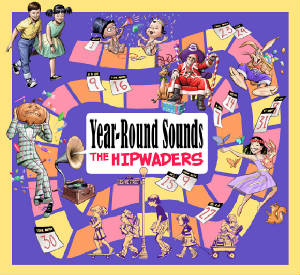From the opening lines of "Dancin' in the Kitchen," the title track to Cathy Fink and Marcy Marxer's new album, it's clear the duo means business with the album's full title, Dancin' in the Kitchen: Songs for All Families. "Dancin' in the kitchen / with mama and mommy / dancin' in the kitchen with me…" they sing, with the entire song celebrating families off all stripes -- two moms, two dads, all sorts of families.
Fink and Marxer -- who themselves married each other last year -- aren't the first kids' artists to record a song about people who identify as BGLTQ or even families with gay or lesbian parents, but the inclusion of that song in this album is a step towards including those families as part of the overall diversity of family types in this country (and kids music). In fact, more than half of the album are not new songs, but songs from artists like Justin Roberts and Uncle Ruthie Buell that fit within the broad rubric of "family," which kindie godparent Marlo Thomas defines as "a feeling of belonging" (it's the definition that the duo says they like most).
The album works best when it's celebrating the everyday-ness of families -- on the title track, for example, or on "Birthday Pup," a Lou and Peter Berryman tune detailing two dogs' many yearly birthdays, which Marxer performs here with Riders in the Sky. Fink's "Twins," recorded with the Canote Twins (actual identical twins), and their Irish medley with Cherish the Ladies "Howdy Little Newlycome/Ceilidh House Polka" are examples of what I think of as one of Fink and Marxer's greatest strengths -- finding other interesting artists to make music with, and plugging themselves in, as it were, to those musicians' talents, especially when those talents mesh well with Fink's and Marxer's bluegrass and roots music skills.
Some folks may find the balance of "message" (even if it's one they support wholeheartedly) and fun of the music sometimes tips uncomfortably toward the "message," but that may depend on whether or not you feel like you've heard your family's story -- or other families' stories -- before. I'm a parent of an adopted child, for example, and while I'm glad John McCutcheon's "Happy Adoption Day" has been around for a couple decades (Fink and Marxer offer their own version here), I've always only been "meh" on the song itself.
The 58-minute album is most appropriate for kids ages 4 through 9. I think Dancin' in the Kitchen will be popular for its content and message, and a fair number of the songs here would have been appropriate on a wide variety of albums, not just one labeled "family." Even if every song doesn't work for me, I'm glad for this album's existence. Recommended.
Note: I received a copy of the album for possible review.












